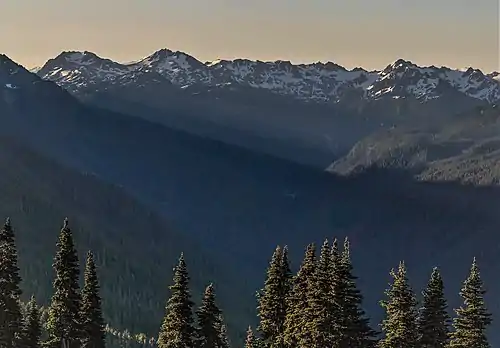Mount Childs
Mount Childs is a 6,193-foot (1,888-metre) mountain summit in Olympic National Park in Jefferson County of Washington state. Mount Childs is part of the Bailey Range, which is a subrange of the Olympic Mountains, and is set within the Daniel J. Evans Wilderness.[5] Neighbors include line parent Mount Pulitzer, 1.7 mi (2.7 km) to the north, Mount Barnes, 2 mi (3.2 km) to the south, and Mount Olympus is situated 5.6 mi (9.0 km) to the west.[3] Precipitation runoff from the mountain drains west into headwaters of the Hoh River, and east into Goldie River, which is a tributary of the Elwha River. The first ascent of the summit was made August 6, 1961, by Doug Waali, Bob Wood, and Kent Heathershaw via the east slope.[6]
| Mount Childs | |
|---|---|
 North aspect | |
| Highest point | |
| Elevation | 6,193 ft (1,888 m)[1] |
| Prominence | 533 ft (162 m)[2] |
| Parent peak | Mount Pulitzer (6,283 ft)[2] |
| Isolation | 1.71 mi (2.75 km)[2] |
| Coordinates | 47°48′44″N 123°35′11″W[3] |
| Naming | |
| Etymology | George William Childs |
| Geography | |
 Mount Childs Location of Mt. Childs in Washington  Mount Childs Mount Childs (the United States) | |
| Location | Olympic National Park Jefferson County, Washington, US |
| Parent range | Olympic Mountains Bailey Range |
| Topo map | USGS Mount Queets |
| Geology | |
| Age of rock | Eocene |
| Climbing | |
| First ascent | 1961[4] |
| Easiest route | class 2 scrambling[2] |
Etymology
A peak was named by the Seattle Press Expedition to honor George William Childs (1829–1894), publisher of the Philadelphia Public Ledger newspaper.[7] That peak is today known instead as Mount Barnes, and Mount Childs now resides two miles north of its original position.[7] The name has not been officially adopted by the United States Board on Geographic Names, so the peak is not labelled on USGS maps.
Climate
Based on the Köppen climate classification, Mount Childs is located in the marine west coast climate zone of western North America.[8] Most weather fronts originate in the Pacific Ocean, and travel east toward the Olympic Mountains. As fronts approach, they are forced upward by the peaks of the Olympic Range, causing them to drop their moisture in the form of rain or snowfall (Orographic lift). As a result, the Olympics experience high precipitation, especially during the winter months. During winter months, weather is usually cloudy, but due to high pressure systems over the Pacific Ocean that intensify during summer months, there is often little or no cloud cover during the summer.
Geology
The Olympic Mountains are composed of obducted clastic wedge material and oceanic crust, primarily Eocene sandstone, turbidite, and basaltic oceanic crust.[9] The mountains were sculpted during the Pleistocene era by erosion and glaciers advancing and retreating multiple times.

References
- Olympic Mountain Rescue, Olympic Mountains: A Climbing Guide, 4th Edition, 2006, Mountaineers Books, ISBN 9780898862065, page 195.
- ""Mount Childs" – 6,193' WA". listsofjohn.com. Retrieved 2022-01-26.
- "Mount Childs". Peakbagger.com.
- First Ascents, climbersguideolympics.com
- Robert Wood, 1988, Across the Olympic Mountains: The Press Expedition, 1889–90, Mountaineers Books, ISBN 9781594858284, page 217.
- Roy Etten, North America, United States, Washington, Olympic Mountains, New Climbs in the Bailey Range, (1962), American Alpine Journal
- Parratt, Smitty (1984). Gods and Goblins: A Field Guide to Place Names of Olympic National Park (1st ed.).
- Peel, M. C.; Finlayson, B. L.; McMahon, T. A. (2007). "Updated world map of the Köppen−Geiger climate classification". Hydrol. Earth Syst. Sci. 11: 1633–1644. ISSN 1027-5606.
- Alt, D.D.; Hyndman, D.W. (1984). Roadside Geology of Washington. pp. 249–259. ISBN 0-87842-160-2.
External links
- "Olympic National Park". National Park Service.